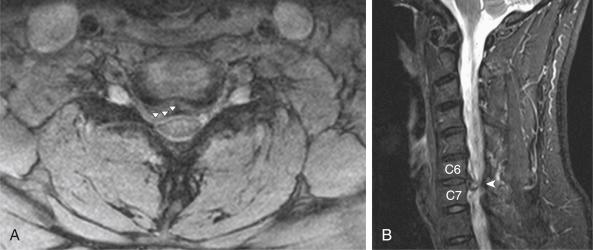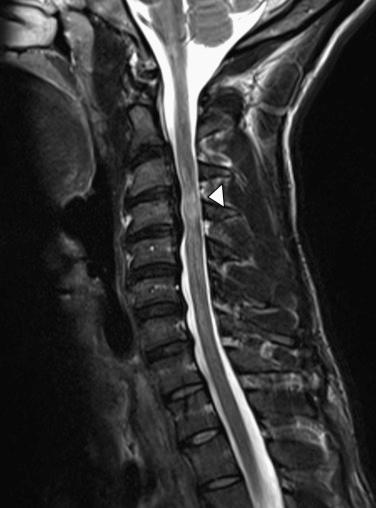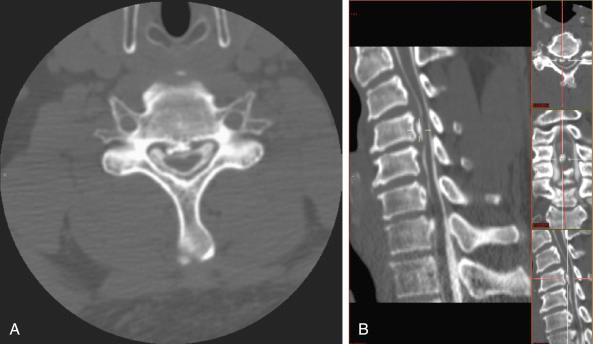Physical Address
304 North Cardinal St.
Dorchester Center, MA 02124
|
|
|
|
|
|
|
|
|
|
Cervical spondylosis refers to age-related degenerative changes of the cervical spine that are seen throughout the entire adult population. Most of these changes are asymptomatic; however, when they are symptomatic, they manifest as axial neck pain, radiculopathy of the upper extremity, or cervical myelopathy. These symptom complexes can be caused by a variety of degenerative changes. These changes include disk degeneration, disk herniation, facet arthrosis, and osteophytic spur formation. Degenerative changes within cervical disks are most often a result of desiccation of the disk, which leads to a cycle of progressive degenerative changes that can result in compression of neural structures and cause radiculopathy, myelopathy if the spinal cord is compressed, or a combination of both as in myeloradiculopathy.
Anterior cervical diskectomy and fusion (ACDF) are frequently used for treatment of cervical degenerative disease. The ACDF procedure is used to decompress an exiting nerve root to treat radicular symptoms, and it is also used for treatment of cervical myelopathy if the compressive disorder is anterior to the spinal cord. The ACDF procedure is performed through an anterior cervical approach that is described in further detail in Chapter 3 . This chapter discusses preoperative considerations, surgical technique, and postoperative care related to ACDF.
A careful history and physical examination should be performed on any patient presenting with neck or arm pain. Patients frequently present with axial neck pain; however, axial neck pain secondary to degenerative disk disease alone is typically not an indication for surgery. However, patients also frequently present with radicular symptoms. These symptoms include burning or radiating pain extending distally in the affected arm, typically in a specific nerve root distribution, although occasionally the symptoms may not always follow a specific dermatomal pattern. In addition to pain, patients can also present with paresthesia and, less commonly, motor weakness in the affected extremity. These symptoms can frequently be exacerbated by specific head positions, such as the neck in extension with rotation toward the affected extremity (Spurling sign).
The clinician must also attempt to elicit any myelopathic symptoms. Frequently, the patient must be questioned specifically regarding myelopathic symptoms because he or she may not relate them to the presenting complaint. Patients should be questioned about changes in their handwriting, or difficulty with fine motor coordination of the fingers in the affected extremity. Asking a patient whether he or she has noticed any difficulty handling change or keys can often elicit a history of this symptom. Patients must also be questioned about any difficulty with walking or balance. A patient may have noted significant difficulty with balance but may not provide this information unless questioned because the presenting complaint is neck or arm pain.
A complete and thorough neuromuscular examination should focus not only on the extremity from which the patient’s symptoms and signs stem but also the asymptomatic extremity. This information provides a valuable comparison for all aspects of the examination. Moreover, neurologic findings may be normal in many patients with radicular pain.
The motor examination should focus on all muscle groups of the upper extremities. The examination should be performed sequentially, with specific comparisons with the asymptomatic extremity. Asymmetric motor weakness along with the specific location of sensory changes can help localize the level of the possible disease. Additionally, deep tendon reflexes should be tested and compared with the asymptomatic extremity. Specifically, the biceps, brachioradialis, and triceps reflexes should be tested. Changes in deep tendon reflexes with radiculopathy often show asymmetric decrease in deep tendon reflexes specific to the site of compression. Alternatively, a myelopathic patient may have hyperactive deep tendon reflexes, possibly accompanied by Hoffmann sign and sustained clonus. The presence of pathologic reflexes should raise the suspicion of an upper motor neuron lesion.
Preoperative imaging is a crucial part of both the workup of a patient with radicular or myelopathic symptoms and for preoperative planning. Plain radiographs are typically the initial study of choice and should include standing anteroposterior and lateral radiographs, along with lateral flexion and extension films. These images are of limited value in evaluating possible neural compression, but they provide valuable information about overall spinal alignment, stability, and the presence of bony disease.
If advanced imaging is desired, then magnetic resonance imaging (MRI) is the modality of choice. Among other things, the MRI provides excellent imaging of the neural elements, surrounding soft tissue structures, the intervertebral disks, and the vertebral artery ( Fig. 30-1 ). In the presence of stenosis, MRI allows for localization of the compressive structure and assessment for evidence of myelomalacia or spinal cord edema ( Fig. 30-2 ). If the patient is unable to undergo MRI, or if assessment for bony compression is required, then computed tomography (CT) myelography is the next imaging modality of choice. This method provides good resolution of both neural elements and bony structures ( Fig. 30-3 ).



Thorough history, physical examination, and imaging typically help determine whether the disorder is most likely cervical. However, a list of differential diagnoses should include, among other things, cervical radiculopathy, cervical myelopathy, brachial plexus injury, complex regional pain syndrome, thoracic outlet syndrome, inflammatory arthropathy, shoulder disease, peripheral nerve compression (cubital tunnel syndrome or carpal tunnel syndrome), multiple sclerosis, diabetic neuropathy, stroke, syringomyelia, Guillain-Barré syndrome, normal-pressure hydrocephalus, and spinal cord tumor. In selective cases, the use of electromyography and nerve conduction studies can also help to assist in determining the source of the disorder.
Become a Clinical Tree membership for Full access and enjoy Unlimited articles
If you are a member. Log in here